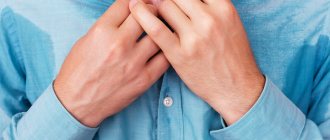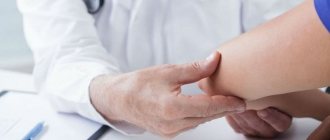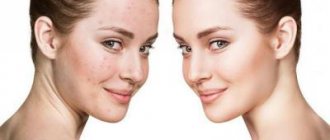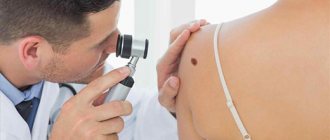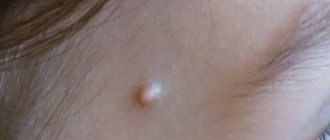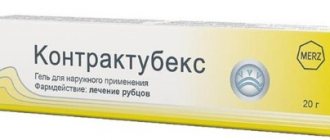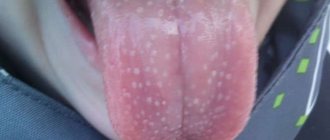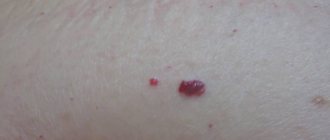- Zinc ointment is an antiseptic and drying agent that reduces the production of sebaceous gland secretions.
- Salicylic ointment is an anti-inflammatory composition, which also helps exfoliate dead cells.
- "Levomycetin" (solution) is an antimicrobial, disinfectant with a drying effect.
Auxiliary action is provided by:
- Chamomile and string are natural antiseptics that relieve irritation and soothe the skin. They are used in the form of decoctions for rubbing, compresses and baths.
- Tea tree oil is an anti-inflammatory, soothing agent that can reduce sweating.
When traditional medicine is powerless, a dermatologist can suggest that a patient with acne from sweat use radical methods - laser exposure and current therapy, removal of sweat glands.
Treatments are available that may help when conventional treatment fails. Such procedures require medical supervision. Pulse therapy with oral antifungals, antihistamines and antibiotics, laser removal of acne or the use of galvanic current may be useful, but there are a number of side effects that the doctor takes into account when prescribing.
Causes
Allergy to sweat
Acne may occur due to an allergy to substances found in sweat (cholinergic urticaria). This rather rare diagnosis is not made without consultation with an allergist or dermatologist. Rashes appear not only due to a reaction to your own sweat, but also when coming into contact with the sweat of another person. This rash occurs when body temperature rises as a result of heat or physical activity, which leads to the production of histamine. Often the cause of allergies can be disturbances in the functioning of the digestive tract and thyroid gland.
Symptoms of an allergy to sweat are as follows: as soon as the process of sweating occurs, pale red blisters up to several millimeters in diameter with bloody areas around the circumference appear on the face, neck, chest, and back. The person feels itching in the affected areas. If complications occur, vomiting, coughing attacks and difficulty breathing may occur. The most dangerous consequence may be anaphylactic shock. If you do not immediately take an antihistamine, a person’s blood pressure drops sharply, weakness, tachycardia appear, and loss of consciousness may occur.
Excessive sweating (hyperhidrosis)
Often such a misfortune as sweat pimples overcomes people suffering from excessive sweating. Its exact reasons have not yet been established. Increased secretion of sweat glands can occur from diseases of the nervous and hormonal systems, metabolic disorders, physical stress or anxiety. In severe cases of the disease, new pimples appear almost daily.
Seborrhea
With hormonal imbalances, especially during the period of changes in the hormonal levels of a teenager, disruption of the secretion of the sebaceous glands, the skin is prone to inflammation and the appearance of acne. With the passage of puberty, both the symptoms and the disease itself usually disappear.
Prickly heat
Sweat rashes in adults and children can arise from a disease such as prickly heat. The disease is caused by skin irritation due to the large amount of sweat produced, and is often observed in obese people. Acne in summer is caused by hot climate and acclimatization. Miliaria can occur even in infants due to imperfect heat exchange. This disease is not contagious and only causes discomfort.
It appears as a small, white, blistering rash filled with fluid (crystalline miliaria is the safest type of the disease). Sometimes the body temperature rises and redness occurs (due to the appearance of a concomitant infection). This variety is called prickly heat. It causes the skin to itch and hurt. Usually appears in areas where the skin is tender or rubbed by clothing. Miliaria rubra progresses to the papular form. The reason may be moving to a place with a hot, humid climate. First, blisters appear, then a papule with blisters forms. Then they dry out and form a crust. The rash can occur on any part of the body.
Causes of acne on the face in women, teenagers and men
- One of the common causes of acne on the face is clogged pores. When the pores on the facial skin are clogged, then pimples and blackheads appear - this means that the skin does not breathe properly. This happens due to the accumulation of fat, bacteria and dead cells. Most often, acne appears in the T zone of the face.
- Hormonal changes most often relate to adolescence, so they are not something out of the ordinary.
- You are over-cleansing your skin. Many people with acne problems think that the more they cleanse their skin, the less acne there will be and the skin will be smoother, for this reason they begin to use rough cleansers (for example, crushed apricot kernels) or scrub their face with brushes. But in fact, this will only inevitably make the problem worse.
- Diseases of the gastrointestinal tract are a problem of the 20th and 21st centuries, since people often choose unhealthy fast food as food. All the accumulated toxins trying to come out through the skin pores also cause inflammation and lead to acne.
- Stress can cause acne to appear on your face. Basically, when you're under pressure, your skin produces stress hormones including cortisol and testosterone, which can stimulate your sebaceous glands, increasing sebum production and clogged pores.
- Alcohol abuse is a common cause of acne. Since alcohol-containing drinks are considered harmful for consumption, some of the toxins are eliminated through the pores of the skin, thereby blocking them. Therefore, the skin may become inflamed.
- Another reason is smoking. Every time you smoke a cigarette, you reduce the amount of oxygen in your skin. This leads to a decrease in collagen and elastin, which in turn leads to wrinkles and increased pore size. The carcinogens in smoke also irritate and dry out the skin, causing your skin to produce more sebum, which clogs the pores and subsequently forms a pimple.
- The most difficult causes of acne are hormonal and genetic factors. Your skin may simply be acne-prone. Changes in hormones observed due to the menstrual cycle or pregnancy can disrupt the normal functioning of the skin. In these cases, pimples may appear on your face.
- The most common causes of acne are: excessive use of cosmetics.
DETAILS: Rose essential oil for face properties reviews application
In order to resist adversity, it is easier to warn it in advance.
Since the face is the most open area of human skin, it reflects both the negative impact of an aggressive external environment and problems within our body. He looked at his face, and everything was written on it, as if it were a “personal file.” And therefore, the “façade,” as L. Gurchenko’s heroine said in the famous film, must be protected and taken care of.
Let's figure out together what we're doing wrong and whether we ourselves are to blame for the fact that our face has suffered an evil fate - imperfections have settled on it. Without knowing the reason, we immediately ask ourselves: how to get rid of acne faster? It would not be more logical to start with what the roots of the problem are.
- We girls always need to remember that belonging to the fair half of humanity also makes us part of its weaker half, since throughout their lives women go through more than one “hormonal milestone,” which does not always have a beneficial effect on the appearance of their facial skin. . Even to hormonal medications, our skin often reacts with “poppy seeds” and acne. Diseases of the reproductive organs and problems with the endocrine system in women also lead to hormonal imbalances, and this is stress for the skin of the face.
- Puberty is a time when complex restructuring processes occur in a teenager’s body. At the biological level, two revolutions occur during puberty: in hormonal regulation and in the emotional and psychological sphere. Teenagers live in a state of constant extreme stress and hormonal explosion - this cannot but affect the condition of the skin of the face. Not only do the sebaceous glands actively begin to produce their secretions due to age-related changes, but also the individuals themselves, who are on the way to a sexually mature state, due to youthful nihilism, deny all regular nutrition enriched with vitamins and minerals. It's no secret that children at the age of 12 or so delve into the theory of nutritious healthy eating.
- The cause may be toxins that accumulate in the liver, kidneys and intestines. Finding no other way out, they will appear on the face or body.
- A monotonous, irregular diet, depleted in vitamins, microelements, fiber, but rich in transgenic fats and simple carbohydrates, contributes to the formation of skin rashes.
- Modern life in a regime of continuous stress, poor quality sleep prevents the body from recovering, which is reflected on the face.
- Acne can also be of the allergic type. In the modern world, there are many people with allergies in the environment: questionable food products, aggressive cosmetics, allergenic fabrics, household dust, etc.
Treatment and prevention
To prevent the appearance of acne due to increased sweating, it is recommended to follow some simple rules:
- Touch your face as little as possible. Bacteria from the hands, when interacting with the sweat glands, can trigger the onset of the inflammatory process.
- Wash your face several times a day or wipe it with special cleansing and anti-inflammatory lotions.
- Do exercises regularly, or better yet, exercise.
- After playing sports, you must carefully wash off dirt and sweat from the skin, which provoke inflammation of the glands.
- Drink as much water as possible to improve your metabolism and dilute sebum and sweat, thereby preventing clogged glands.
- If possible, avoid synthetics that retain moisture during sweating.
- Use talc and deodorants. They absorb excess sweat.
- Replace your usual washing powder with organic soap that will not irritate your skin.
- Monitor your nervous system. Stress and intense anxiety provoke the production of sweat.
- When a specialist diagnoses cholinergic urticaria, hyperhidrosis, seborrhea or miliaria, the disease should be treated under the guidance of an experienced doctor.
Treatment of sweat allergies
Unfortunately, effective medications against sweat allergies have not yet been developed, so it will not be possible to get rid of it forever. Medicines can only reduce symptoms. You can improve your skin condition by adhering to the above recommendations and following the following tips:
- Wash off sweat with hypoallergenic soap.
- If you have breathing problems, instill anti-allergenic drops with a vasoconstrictor effect.
- After the skin is completely dry, apply anti-allergenic ointment to it.
- Take orally any anti-allergy drug prescribed by your doctor.
- If the itching is very severe, you can inject a hormonal drug.
If you have products with salicylic acid on hand, they will dry and soothe the skin. You can try to get rid of pimples using folk remedies: decoctions of yarrow, celandine, chamomile, calendula, string.
Treatment of hyperhidrosis
Today there are three effective ways to get rid of hyperhidrosis:
- Iontophoresis procedure using a special physiotherapeutic device – drionic. It can be done at home. But this needs to be done every month, since after this time the sweat glands begin to work actively again.
- Using sympathectomy surgery. A special device clamps the nerve connected to the sweat gland. After the operation, increased sweating stops.
- For hyperhidrosis in the axillary area, you can perform an operation - curettage, with the help of which the sweat glands are removed.
Surgery is a radical but effective way to get rid of skin rashes from sweat.
How to get rid of it at home?
- To prevent prickly heat, you should wear light, loose-fitting clothing of a suitable size in summer to avoid chafing with the material. After swimming, you need to dry yourself. When the sun is hot, avoid playing sports. Change your underwear and clothes more often. Do not overuse tanning.
- Doctors recommend treating prickly heat using traditional methods. Carrot and pomegranate juices, lentils, plums, and sorrel leaves should be consumed daily.
- You can also make an infusion of pansies. Twenty grams of raw materials pour 1 tbsp. hot water. Leave for fifteen minutes, then cool. Use 1 tsp three times a day.
- Zinc ointment copes well with this disease. Apply it to dry skin six times a day.
- Infants and small children should be rubbed with talcum powder and bathed in a weak solution of potassium permanganate. For adults, the dose of potassium permanganate can be increased. It is good to treat acne from sweat in a child with bepanthen or zinc ointment.
- It is also good to wipe the affected areas with decoctions of birch buds, oak bark, chamomile, yarrow, celandine, and bay leaves.
Don’t worry if you still haven’t been able to find out the cause of the rash. You should definitely consult with a dermatologist and allergist, who will determine the factors influencing the active formation of a skin rash, give valuable recommendations and prescribe effective treatment.
Facial scrub gets rid of acne
You can prepare scrubs at home. An excellent remedy for any type of skin is a coffee scrub. Depending on the characteristics of the skin, different ingredients are mixed with coffee. Let's consider a method of preparing an anti-acne scrub based on coffee.
You can use coffee grounds to create a scrub. Coniferous essential oil is added to it; a few drops will be enough. You can replace the oil with sour cream or cottage cheese if the skin is dry and with low-fat yogurt if it is prone to oiliness. In this case, the ratio of such components in the scrub should be 1:1.
Pressing on the skin is prohibited; movements should be made gently. Circular movements will ensure gentle cleansing of the skin and eliminate the possibility of injury. First, the mixture is left for about five minutes to absorb, and then washed off with cool water.
It is not necessary to mix coffee grounds with other ingredients, since the positive effect on acne is achieved due to the effect of caffeine on the affected skin.
Ingredients for preparing a scrub depending on skin type:
- Dry skin:
Dry skin can also become prone to acne; it needs the gentle treatment of products that nourish and cleanse.
You can prepare a nourishing scrub based on oatmeal. It is necessary to take grape berries (6 pcs.) and crush them, prepare crushed flakes (3 g). The face is massaged for three minutes, after which it is left to absorb for ten minutes and then washed off.
- Combination skin, oily:
Such skin can be subjected to more aggressive effects, namely, the influence of products containing abrasive particles.
Sugar scrub perfectly nourishes this type of skin. It is necessary to choose the cane version (25 g). A tablespoon of milk is added to the main component. It is important that the sugar is not completely dissolved and that grains are present in the resulting mass. Massage movements are performed for four minutes, the composition is kept for seven minutes and washed off.
Pimples from sweat
When the ducts of the sebaceous and sweat glands are clogged, the substances they secrete and waste products of our body accumulate inside, which is why sweat acne appears. The sweating mechanism is responsible for eliminating accumulated toxic compounds in the body, harmful substances, and toxins.
Pimples, also known as comedones or black plugs, can cause significant discomfort, so this symptom should not be ignored.
Localization of inflammation
Possible causes of acne by location
Acne is a problem for many people who sweat intensely - from the heat, in the gym. Sweat acne most often appears on the face, décolleté, back and buttocks. The culprit is sebum, dead cells and pollution found all around us.
Responsibility for poor skin condition also lies with us. The use of inappropriate cosmetics and lack of proper hygiene contribute to inflammation.
After infection gets into an open comedone along with sweat, inflammation forms in the epidermis. Acne begins to spread most often in the face, back, shoulders and décolleté. The easiest way to combat acne is to react to the first signs: regular, innocent-looking blackheads. If treatment is started at the right time, the development of the disease does not threaten. Acne is often caused by sweating, which causes clogging of the sebaceous glands and the proliferation of bacteria, which is why cleansing the skin, for example, after physical activity, is so important.
Pimples appear from sweat
It is also worth mentioning that men have a larger number and size of sebaceous glands than women. Men are less likely than women to wear makeup or use inappropriate skin care products and visit dermatologists almost never. Therefore, it is difficult for them to stop acne at an early stage of development. Men's skin gets dirty faster, which means it becomes susceptible to acne. It has been noted that in adult men, the most common acne caused by sweat is concentrated mainly on the back, chest and shoulders.
Reasons for appearance
Some physical conditions can literally cause the skin to “revolt.” It mainly affects areas where the number of sweat ducts is concentrated with maximum density - the armpit area, elbow joints at the bends, the area under the knees, and the neck area.
The causes of pimples from sweating are:
- Allergic reaction to sweat. Inflammatory processes can develop for various reasons: excessive amounts of pollen, dust in the air, due to the bites of certain insects. Often, allergies appear when the irritant is a certain chemical element or a state of high humidity. Sweating is always accompanied by an increase in humidity in a certain area of the skin, and the impurities and toxins contained in sweat act as strong allergens. Sometimes an allergic reaction occurs when someone else's sweat comes into contact with your skin.
- Hormonal changes. Rashes and pimples can appear not only during adolescence and pregnancy. It is enough for women to experience systematic emotional stress and tense psychological states, which leads to the development of allergies.
- Stressful moments. Actively defending one's own views, intense work process, difficulties in the educational process, sports overexertion - these conditions belong to a serious risk group for the occurrence of pimples.
- The usual diet is of great importance. Incorrect systematic eating is a strong provocateur of allergic reactions and rashes.
The occurrence of pimples for this reason is quite common among young people.
Why do rashes appear?
It’s always easier to avoid a problem than to solve a chronic disease – that’s what the doctor said. He told why acne usually appears. At different ages, the reasons for the appearance are the most unpredictable.
So, in adolescence, the hormonal system fails, the body grows, we adjust to adulthood - and the appearance of pimples is completely justified. Although pustules cause a lot of problems for a teenager - after all, it is at this age that self-doubt worsens and there is a desire to feel in one’s place, to determine who you are among your friends, who likes you and who doesn’t.
Another reason for their appearance is poor nutrition. As you know, many diseases appear precisely because of a poor diet: excessively sweet or fatty foods, the inability to digest cow's milk (animal protein) or allergic reactions. There may be many reasons - but there is only one solution: a comprehensive analysis of the gastrointestinal tract.
Also, many people develop rashes due to a simple lack of hygiene. If you don’t take care of cleanliness, sleep on the same pillowcase for weeks, or don’t remove your makeup before bed, pustules may well appear.
How to get rid of
If the appearance of pimples occurs over minimal time intervals and without serious provoking factors, it is necessary to urgently visit a dermatologist, since this allergic reaction can become the body’s initial signal of an emerging serious disease.
Often, if the allergen is eliminated, the rash goes away on its own, but patients do not always have information about their own body so thoroughly that they can identify the harmful component themselves. If the specialist is sure that the formation of the rash occurred due to normal blockage of sebaceous pores, then it is necessary to resort to the following methods:
- Qualitatively review your diet. Fatty foods and complex foods provoke certain problems of the digestive tract, which result in all kinds of inflammatory and allergic reactions.
- When initially diagnosing a rash, it is necessary to acquire a specialized product that improves the condition of pores and promotes high-quality cleansing of the skin.
- It is recommended to systematically take vitamin supplements, especially those complexes that contain zinc. This element helps fight pimples.
- If the rash occurs in childhood, zinc-containing ointment formulations are suitable for treatment.
For the initial stage of development of pimples, traditional medicine methods can be used. The following plants cope well with the disease:
- aloe. It is enough to wipe the damaged area with plant juice on a daily basis;
- To treat minor rashes, a tincture of white lily petals is suitable. Several flowers are placed in a bottle, then filled with water and left to soak for 2 weeks. Before going to bed, rub your face and other areas where pimples appear with this mixture;
- Oak carp and calendula solution enriched with honey are highly effective.
How to deal with acne?
If the appearance of acne is associated specifically with sweating, you can deal with them quite quickly thanks to:
- Proper hygiene and skin care. First of all, you need to remove the stratum corneum of the epidermis with soft peeling. It is enough to carry out the procedure 1-2 times a week. For washing, you should use a product with a neutral pH. You will have to completely eliminate fatty creams and masks, products containing alcohol and decorative cosmetics that clog pores.
- Changing your diet in favor of healthy foods and a more active lifestyle . Eating, drinking enough fluids and walking in the fresh air will help your skin recover faster.
- Folk remedies that help relieve itching and inflammation. To soothe the skin, a decoction of chamomile, sage, peppermint, tea tree oil and rosemary is perfect.
- Skin cleansing , which can only be performed by a qualified cosmetologist.
On the body
Pimples can occur on absolutely any area of the skin. Areas with constant humidity are more susceptible to rashes - armpits, lumbar and pelvic areas. Rashes often appear on the chest.
If in a normal environment the manifestation of sweat is practically not felt in a healthy person, then for a person suffering from hyperhidrosis, any minimal deviation in the indicators of the internal atmosphere of the room results in serious sweating.
When treating clogged pores over the entire surface of the body, it is best to use complex methods of restorative therapy - baths, physiotherapeutic procedures and drug treatment. When taking baths, it is necessary to carefully select accompanying medicinal herbs; such hygiene procedures are quite effective in the fight against complex hyperhidrosis.
Many experts recommend attending physical therapy procedures as a treatment for general excessive sweating. Various contrast showers, cleansing procedures, and massages help open pores and restore their capacity.
In severe forms of the rash, specialized drugs are prescribed that act on the disease from the inside, bringing all metabolic processes to a more intense level.
When is the best time to consult a specialist?
Seeing a doctor
Acne comes in a variety of forms in women and men. Blackheads and pimples with pus appear on the skin, and underneath are painful cysts and nodules. However, many forms often take a more acute course, so it would be better to consult a specialist (dermatologist, endocrinologist) who will select treatment accordingly.
Acne associated with impaired functioning of the body and juvenile acne cannot be ignored. Depending on the severity, you can fight acne on your own or with the help of a doctor.
A good dermatologist will start with topical therapy and, if this is not enough, move on to more significant medications. Most medications have side effects and often lead to redness of the skin.
You will see a noticeable improvement after 2-3 weeks of treatment. If after this time there are still doubts about the effectiveness of therapy, it is better to seek advice from another doctor.
The lack of treatment for the acute course of such a disease as juvenile acne entails fatal consequences, the removal of which is a very expensive procedure, and sometimes impossible.
These are persistent pigment spots and atrophic scars. These visible consequences can further cause the development of complexes. The young man begins to be ashamed of his appearance, loses faith in himself and his own capabilities.
On the face
The appearance of pimples from prickly heat on the face occurs much less frequently than on other parts of the body. This is associated with constant washing, rinsing and other hygiene procedures, which are carried out on this skin area much more often.
The cause of a rash on the surface of the face is various allergic reactions, especially the perception of food. When consuming low-quality, unwashed products, it is only a matter of time before a rash appears.
To eliminate pimples you need:
- Avoid unnecessary stress. There is no need to be nervous when a rash appears; this provokes the production of hormones that can only intensify the allergic reaction.
- Purchase several types of medicines - masks, cosmetic and medical compositions for treating facial skin.
- Observe the frequency of treatment.
The maximum effect of masks can be achieved if you use them before bed. By evening, the skin of the face is in a depressed state; during the day it is affected by a lot of negative factors - UV rays, dust, sweating in a hot environment. The night mask actively nourishes the skin, cleanses pores, which normalizes its tone.
Using other types of soap
There are other soap options that can treat acne, for example, baby soap, boric soap, and sulfur soap. Soap for children provides gentle care; after its use, the water and acid-base balance is established, the pores are cleaned, which leads to their narrowing. Since the blockage is eliminated, the inflammatory processes also stop.
Antibacterial soap is not suitable for the face. Despite the presence of special products with triclosan, a substance that destroys acne bacteria, the skin becomes very dry. In addition, soap contains many substances that can hardly be called useful. An allergy may develop to synthetic components if there is a high sensitivity to them.
For problem skin, it is useful to use boric soap with a bactericidal effect, which contains a minimal amount of boric acid and additionally uses mink oil. The product removes not only acne, but also blackheads. This is a restorative soap, when used, small cracks and wounds heal. Fighting acne with boric soap is not at all difficult - problem areas are covered with soap foam, and after 1-2 minutes they are washed with warm water.
Impurities from the skin of the face can be easily removed with sulfur soap. They wash their face with it morning and evening. To achieve the best effect, you can keep the product on the skin for half a minute, then rinse with warm water.
Dove cream soap has a gentle effect on the skin, gently cleanses it, moisturizes it, and makes it silky. Sometimes you can use Safeguard soap to wash your face. This product does its job well, but due to the risk of severely drying out the skin, it is better to choose another cleansing option for regular use.
When treating with glycerin soap, you don’t have to worry about drying out your skin. This product is applied to the face in the form of foam and left for 10-15 minutes. After completing the procedure, you need to wash your face using cool water.
Many people have heard about the combination of soap and soda, but have not tested the effectiveness of this mixture on themselves. They are mixed, applied to problem areas, and, after massaging a little, washed off. With daily use and careful skin care, acne should disappear.
Sweat pimples on forehead
Sometimes the rash appears on the most visible area of the face – the forehead. The cause of pimples in this area is the excessive activity of the sebaceous glands of the scalp. If you do not wash your hair every day, substances secreted through sweat through the pores of the head accumulate in the hair. The slightest contact of hair on the clean skin of the forehead causes the spread of infections and microorganisms to the not yet infected area.
To eliminate pimples on the forehead, it is recommended to initially normalize the condition of the scalp. Simply washing your hair with professional shampoos will significantly improve the condition of your pores and stimulate sweat production. A dirty head causes congestion to develop, which gives rise to allergic reactions in nearby areas.
A regular nourishing mask will help restore hair health. By saturating the top layer of skin with nutrients, sweating processes improve, and systematic washing helps wash away excess sweat.
What water is good for acne?
It is known that salt water helps to eliminate rashes. It has an antibacterial and anti-inflammatory effect. To prepare a medicinal solution, it is best to use sea salt, because it is much healthier for the epidermis. This product not only perfectly removes excess sebum, but also exfoliates dead cells.
Regular use of the solution helps normalize the functioning of the sebaceous glands, thereby eliminating shine. You can also make lotions with it.
If you have acne all over your body, then it is very useful to take baths with water and sea salt.
Salt water is often used
On the back
A rash on the surface of the back causes discomfort even to a fairly cheerful person. In the summer, everyone wants to run around in their swimming trunks and take a dip in a cool body of water, but the “attractive” rear view is a serious problem with this enjoyment.
The main cause of rashes on the back is considered to be improper functioning of the endocrine system. When the hormonal balance is disrupted in the sebaceous glands, excessive production of fat occurs, which becomes a serious limiter of sweating. Strong stagnant processes are formed that lead to inflammation - pimples. If you ignore the initial symptoms, pimples turn into purulent, painful formations.
Men are more susceptible to rashes on their backs than the fair sex; their skin is considered oilier. Physical activity, being in stressful situations and other reasons cause the appearance of unsightly pimples.
Prescribing specialized medications allows you to normalize hormonal levels, get rid of nutritional complications and other possible preconditions for the development of pimples. It is possible to improve the effectiveness of treatment by resorting to additional methods of traditional medicine. You can use various herbal decoctions and add healing tinctures to your usual diet.
Does washing with salt water help acne?
Now let's talk about additional water procedures. Namely, how the skin can react to washing with water containing certain impurities. We will tell you only about the most popular mixtures and types of liquids that many people recommend washing your face with to get rid of acne. And the first test subject will be water with salt for acne.
Indeed, it is believed that salts can dry anything and even kill microbes. Why not try to remove acne with its help? But to be honest, this is a false statement. In fact, washing with salt water does little to help treat acne, and in some cases it can even be harmful. You risk simply drying out your skin. Many users noticed that after such a solution, redness and irritation appeared on the face - the skin itched unpleasantly, and during use, a strong burning sensation was felt on the surface of the epidermis.
At the same time, such a mixture does not bring any actual effect. Therefore, we do not recommend using it.
Pimples from sweat on the legs of men
Men are often concerned about the appearance of a rash on the skin of their legs. This happens for various reasons: incorrectly selected clothes in hot weather, the components of the clothing fabric are predominantly synthetic, constant pollution and lack of hygiene procedures. Most often, construction workers, summer residents and anyone associated with labor suffer from similar problems.
Maintaining cleanliness of the lower torso and limbs is an important component of overall health. If a person wears warm pants in hot weather, then it becomes a matter of time before a lot of sweat appears on the feet. A constant state of moisture is a favorable environment for the development of bacteriological microorganisms, the waste products of which clog the sweat glands. The accumulation of waste and sebaceous fat under the skin causes the development of an inflammatory process.
With constant physical activity, many athletes use a lot of biological supplements and other drugs that disrupt hormonal levels. Such failures lead to improper functioning of the excretory system, which affects the sweat glands.
Sometimes the appearance of pimples is associated with natural causes, for example, ingrown hairs become causative agents of inflammatory processes. The hair follicle gradually swells, if the contents have nowhere to go, purulent stagnation begins to develop.
A common cause of a rash is hypothermia or the presence of infectious colds.
Facial soap as a popular acne remedy
We suggest making your own cleansers at home. This will not only save money, but will also add confidence that the product used contains only natural ingredients. For oily skin, you should use oils or decoctions from the following herbs and plants:
- chamomile;
- sage;
- plantain;
- aloe;
- calendula;
- series;
- jojoba;
- tea tree;
- lavender;
- rosemary;
- fir;
- sea buckthorn;
- Oak bark;
- St. John's wort;
- sagebrush;
- eucalyptus;
- cloves and others.
In addition to plant extracts, it is advisable to add honey, lemon juice, acids, milk, etc.
Cosmetologists often claim that washing with soap has a bad effect on the skin due to the high level of surfactants in its composition. There is an opinion that these components disrupt the lipid layer of the skin and provoke problems such as peeling, dryness, and the appearance of comedones.
DETAILS: How to get clear, acne-free skin at home?
If you don’t know whether you can wash your face with soap, but find this option very convenient, use this product when your skin becomes covered with acne. This is acceptable, the main thing is to understand which soap is best to wash your face so as not to worsen the condition of your skin even more. Among the possible options are laundry soap, tar and glycerin.
Tar soap works well to remove excess sebum. The main component is birch tar, which, due to its properties, has a positive effect on the epidermis. This product is considered unique due to its powerful antiseptic effect on the skin.
You can find out for yourself whether this method helps in the fight against skin rashes by trying to treat acne with tar soap.
The tar product is inexpensive, but the effect of its use is no worse than after treatment with expensive drugs. The method of application is simple, just know how to wash your face correctly. This procedure must be performed twice a day, in the morning and evening. The product has a lot of advantages; you need to understand what effect it has and how to use soap made from birch tar.
Now you know how to use tar soap, and you can always have it with you in case of acne formation and if you need to quickly improve your appearance. The effect is noticeable within a few days - narrowing of pores, clean and healthy skin, reduction of inflammation. Soap has an unpleasant odor, but this disadvantage is insignificant compared to its advantages.
Not every person will risk treating acne with laundry soap, wondering if it helps. First, this product actually performs the necessary task - it removes sebum, which in the presence of acne is present in excess. To obtain the maximum effect, household soap is combined with other substances, for example, a fairly popular treatment based on soap and salt.
At first it seems that using this tool makes sense and it really helps to fix the problem, but this is not so. It is not recommended to use laundry soap as a remedy against acne, despite its popularity.
This product is called volcanic (black soap). As a result of many experiments, it was found that the product from the ash of a volcano is a unique soap, an excellent absorbent. Volcano ash, combined with other soap components, absorbs oil and other impurities present on the surface of the skin.
Volcanic soap performs several tasks at once:
- eliminates acne and oily shine;
- destroys bacteria;
- cleanses pores of blackheads;
- nourishes the skin.
This is a miracle soap with unique properties and amazing effects on the skin. Depending on the severity of the problem, use it once or twice a day for a month.
The scrub removes dead cells and should be used periodically by anyone, both with and without acne.
Can I use a scrub for acne? This question often arises for those whose skin is often covered with acne. You can scrub the affected skin, but use special products and very carefully.
The scrub is a strong cleanser. It penetrates the pores and eliminates their contents. With its help you can get rid of acne and blackheads. It is important to choose the right acne scrub to suit your skin type.
You can purchase a ready-made scrubbing product, for example, Garnier Scrub, which does a good job of clearing acne from the skin, or make it yourself.
How to wash your face to prevent acne? Foaming cleanser is often used to remove dirt and makeup from the face. This is the most popular product of all products of this type. If the presence of acne on the skin is a common problem, you should select a special product whose action takes this problem into account. If you are prone to allergies, it is recommended to choose a hypoallergenic option.
Useful tips
When diagnosing an allergic reaction to your own sweat, you must make every effort to limit the process of hyperhidrosis. For this purpose, specialized pharmaceutical preparations are suitable that can dry the skin, ensure cleanliness of the skin, and reduce the number of pathogenic microorganisms. It is allowed to use not only pharmaceutical drugs; cosmetic ointments, sprays and other formulations are also highly effective in combating this disease.
If severe sweating develops, you should immediately consult a doctor, and the treatment itself should consist primarily of surgical methods. Some people choose to partially cut out the top layer of skin, but surgery to artificially limit the activity of the sweat glands is considered more gentle and effective.
For each specific case, it is necessary to apply specific targeted treatment. But a simple preventive set of hygiene measures will prevent the disease from becoming severe.
Recommendations for preventing new pimples
To prevent pimples from bothering you in the future, you need to adhere to the following recommendations:
- Clean problem areas of the skin from dust and dirt several times a day.
- Use natural products that do not dry out the skin.
- Try to touch problem areas of the skin with your hands as little as possible during the day. This way, fewer pathogenic microorganisms will spread, and it will not become inflamed.
- Lead a healthy lifestyle - review your eating habits (exclude fried and fatty foods, fast food, carbonated drinks, spicy foods), minimize sugar intake, and exercise regularly. This will cleanse the body of toxins and increase metabolism. As a result, the skin will become softer, clearer and more elastic.
- Prevent and promptly treat hyperhidrosis.
- Drink sufficient amounts of clean water.
- Perform comprehensive skin cleansing using natural products without the use of fragrances, fragrances and preservatives.
Everyone's health is in their own hands. Attentive attitude towards yourself and timely treatment, prevention of any pathology is the key to a healthy, long life.
Prevention
No known preventive method can provide a full guarantee of the impossibility of developing hyperhidrosis, but systematic implementation of certain procedures can reduce this probability to a minimum. Many people who maintain hygienic cleanliness never encounter this problem.
A set of measures to prevent sweating consists of:
- Throughout the day, you should cleanse your face with regular soap or specialized anti-acne products.
- Avoid unnecessary touching of your face with dirty hands. Upon contact, microorganisms remain on the surface of the skin, which subsequently become the causative agents of the rash. If contact occurs, a damp cloth or regular towel will help clean your face.
- Since hormonal imbalances largely determine problematic allergic reactions, stimulating this background helps maintain normal skin condition. To do this, you need to maintain systematic physical activity, you can go to fitness, any type of physical activity.
- After performing physical exercises, you should definitely take a shower. It does not matter whether sweat is felt on the surface of the skin or not, when releasing internal energy, the sweat glands release moisture, which, when dried, becomes a potential irritant.
To fully implement these rules into everyday life, many people will have to change their usual lifestyle, but the benefits of such an impact cannot be overestimated.
Preparing cleansers at home
Such products help restore skin balance. Get rid of acne, comedones, blackheads and oily sheen.
It will help remove acne and relieve inflammation. Will nourish and cleanse oily facial skin.
- pour 200 ml of boiled room water into a mug;
- add 10 ml of liquid bee honey;
- mix with 6 drops of lavender essential oil;
- All ingredients are mixed and the composition is ready for washing.
This remedy has an anti-inflammatory and cleansing effect. Dries out pimples and eliminates irritation.
- in a jar mix yarrow, St. John's wort and sage 10 g each;
- pour boiling water and leave for 2 hours;
- filter and use.
Eliminates oily shine and relieves problematic skin.
- In a large container, mix plantain, mint and chamomile, 20 g each;
- pour boiling water and leave for an hour;
- strain and add 5 g of potato starch;
- wash your face twice a day.
All presented face washes do an excellent job with problematic facial skin. Even if the rash does not go away for a long time, there is no need to despair, continue to use the product, as some time must pass for the result to be visible. Choose what you liked the most. Don't forget to test for an allergic reaction and, most importantly, don't get carried away with washing your face. Frequent use will only negatively affect the skin.
